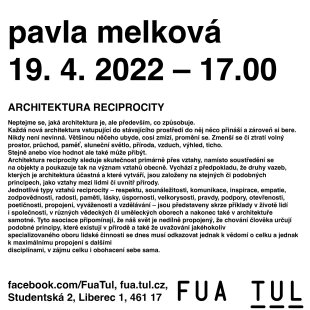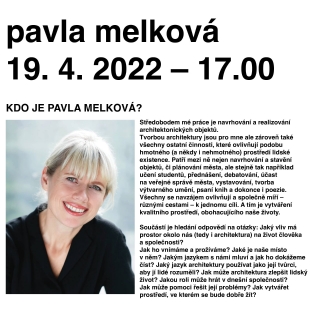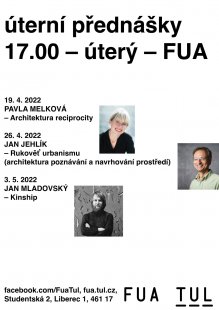
Pavla Melková: Architecture of Reciprocity - Lecture at FUA TUL
Source
FUA TUL
FUA TUL
Publisher
Tisková zpráva
17.04.2022 10:35
Tisková zpráva
17.04.2022 10:35
Lectures
Czech Republic
Liberec
Pavla Melková
MCA atelier
Let's not ask what architecture is, but primarily what it causes. Every new architecture entering an existing environment brings something with it and simultaneously takes something away. It is never innocent. Usually, something diminishes, something disappears, transforms. Free space, passage, memory, sunlight, nature, air, views, and silence may decrease or be lost. Likewise, or even more valued aspects can also increase. Architecture of reciprocity primarily observes reality through relationships, rather than focusing on objects and thus highlights the importance of relationships in general. It is based on the assumption that the types of bonds in which architecture participates and which it creates are based on the same or similar principles as the relationships between people or within nature.
The various types of reciprocity relationships - respect, belonging, communication, inspiration, empathy, responsibility, joy, memory, love, thrift, generosity, truth, support, openness, poetic qualities, connection, balance, and education - are presented through examples in the lives of people and society, in various scientific or artistic fields, and ultimately also in architecture itself. These associations remind us that our world is intrinsically interconnected, that human behavior is determined by similar principles that exist in nature, and that the thinking of any specialized field of human activity today must refer to both the awareness of the whole and the maximum connection with other disciplines for the sake of the whole and enriching oneself.
Who is Pavla Melková?
The focal point of my work is the design and realization of architectural objects.
However, for me, the creation of architecture also includes all other activities that influence the form of the material (and sometimes immaterial) environment of human existence. This includes not only the design and construction of objects or city planning but also, for example, teaching students, giving lectures, debating, participating in public city administration, exhibiting, creating visual art, writing books, and even poetry. All these activities influence each other and together aim - through various paths - towards one goal. And that is the creation of a quality environment that enriches our lives.
Part of it involves searching for answers to questions: What influence does the space around us (thus also architecture) have on the life of an individual and society?
How do we perceive and experience it? What is our place within it? What language does it speak to us, and how can we read it? What language of architecture should its creators use so that people understand it? How can architecture improve human life? What role can it play in today’s society?
How can it help solve its problems? How can we create an environment in which it is good to live?
The various types of reciprocity relationships - respect, belonging, communication, inspiration, empathy, responsibility, joy, memory, love, thrift, generosity, truth, support, openness, poetic qualities, connection, balance, and education - are presented through examples in the lives of people and society, in various scientific or artistic fields, and ultimately also in architecture itself. These associations remind us that our world is intrinsically interconnected, that human behavior is determined by similar principles that exist in nature, and that the thinking of any specialized field of human activity today must refer to both the awareness of the whole and the maximum connection with other disciplines for the sake of the whole and enriching oneself.
Who is Pavla Melková?
The focal point of my work is the design and realization of architectural objects.
However, for me, the creation of architecture also includes all other activities that influence the form of the material (and sometimes immaterial) environment of human existence. This includes not only the design and construction of objects or city planning but also, for example, teaching students, giving lectures, debating, participating in public city administration, exhibiting, creating visual art, writing books, and even poetry. All these activities influence each other and together aim - through various paths - towards one goal. And that is the creation of a quality environment that enriches our lives.
Part of it involves searching for answers to questions: What influence does the space around us (thus also architecture) have on the life of an individual and society?
How do we perceive and experience it? What is our place within it? What language does it speak to us, and how can we read it? What language of architecture should its creators use so that people understand it? How can architecture improve human life? What role can it play in today’s society?
How can it help solve its problems? How can we create an environment in which it is good to live?
The English translation is powered by AI tool. Switch to Czech to view the original text source.



0 comments
add comment
Related articles
0
10.10.2025 | Petr Tej: Bridges - Lecture at FUA TUL
0
26.03.2023 | P.Melková, A.Gormley: The Gravitational Field of the Unutterable
0
24.05.2022 | Petr Janda: About Work, Joys, and Struggles - Lecture at FUA TUL
0
17.05.2022 | Zdeněk Jiran: Spatial Concept of Architecture - Lecture at FUA TUL
0
23.04.2022 | Jan Jehlík: Handbook of Urbanism - Lecture at FUA TUL
0
13.03.2022 | Perception of Space: Miroslav Petříček and Pavla Melková - Discussion at Gallery VI PER
0
29.10.2020 | Pavla Melková: How to Bring a Monument to Speech
0
03.06.2020 | Architecture of Reciprocity - invitation to the opening at GJF
0
02.03.2018 | Pavla Melková, Rostislav Švácha: Poetry - architecture











